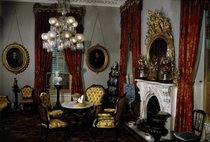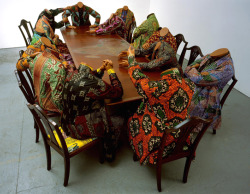At the Brooklyn Museum* on Friday, I stopped in to see the just-opened Yinka Shonibare MBE exhibition, which runs through Sept. 20. Unbeknownst to me, it beautifully illustrates one of the
 strategies I was going to bring up at my lunch with Director Arnold Lehman for getting people interested in seeing museums’ permanent collections. Lehman and the museum’s curators were one step ahead of me: they had already displayed some of Shonibare’s works within the permanent collection galleries.
strategies I was going to bring up at my lunch with Director Arnold Lehman for getting people interested in seeing museums’ permanent collections. Lehman and the museum’s curators were one step ahead of me: they had already displayed some of Shonibare’s works within the permanent collection galleries.
Most of the Shonibare show is on view in the fourth-floor special exhibitions galleries, with a couple pieces on the first floor, too. But Brooklyn also asked him to make site-specific works that are on display — surprise — in its period rooms.
Retailers have used this strategy for years — setting up boutiques for, say, Coach leather goods in a department store. When shoppers go in to buy a Coach bag, they stay to shop for other merchandise. (Well, they did.)
What Brooklyn did isn’t unique in the museum world, but it’s not common, either; other museums can take a lesson from its example. The execution in the Shonibare show is brilliant.
Brooklyn has wonderful period rooms, ranging from the Milligan House Parlor (above) to a Rockefeller House Moorish Room, yet I’d venture that they get little traffic compared with the rest of the museum. For this installation — called Mother and Father Worked Hard So I Can Play — Shonibare made seven figures of children, headless as usual and dressed in Victorian costumes of the same Dutch wax fabrics he uses in the rest of his show.
One boy is playing with marbles; a girl is playing with a doll under a dining table; a boy is doing a headstand — and so on. You have to look for them, though — they don’t jump out at you. Visitors can either go on a treasure hunt seeking the works, or they can pick up a flyer showing where these children can be found.
 I wish I could show you how good they look, but the museum has not yet taken publicity photos for this part of the show. And the period rooms are behind glass, preventing me from taking my own. Instead, here’s a peek at another work in the show, Scramble For Africa, 2003.
I wish I could show you how good they look, but the museum has not yet taken publicity photos for this part of the show. And the period rooms are behind glass, preventing me from taking my own. Instead, here’s a peek at another work in the show, Scramble For Africa, 2003.
Will this ploy work? If my short time in the galleries is any indication, the answer is yes — people were roaming the period rooms, stopping to look for the Shonibare pieces. Some were oohing and aahing about the rooms, too.
Arnie told me that the museum is in talks with other museums that also have period rooms in hopes that they’ll take this installation. I hope some do.
The Newark Museum, meanwhile, has another site-specific work by Shonibare, a centennial commission — Party Time: Re-Imagine America — going up in the dining room of its marvelous 1885 Ballantine House, opening July 1. The house belong to the wealthy brewing family and Shonibare is staging a late 19th Century dinner party, midway through the multi-course feast.
Aside from using site-specific pieces, there are other ways to make these shows-within-a-show (or gallery) work. I’m not sure there are rules, other than that the relationship between objects has to be real.
Got any examples? Please let me know.
Photo Credits: Courtesy Brooklyn Museum (top); Courtesy of the artist, Stephen Friedman Gallery,
London, and James Cohan Gallery, New York. © the artist. Photo: Stephen White (bottom)
*Disclosure: I consult to a foundation that supports the Brooklyn Museum.
